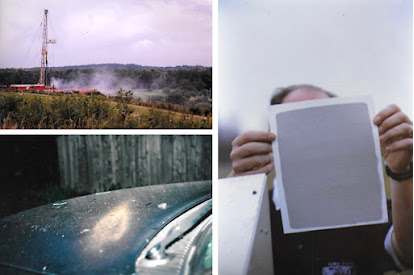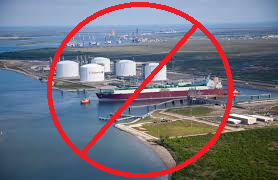Study Links Fracking, Drinking Water Pollution, and Infant Health
May 3, 2022
Ezell: Food and Theatre at Willow Wisp Farm June 3 to 5
May 29, 2022Drillers Dispose of Drill Cuttings by “Dusting” – Blowing Them on the Ground, and in the Air

By David E. Hess, PA Environment Digest Blog, May 2, 2022
PA DEP allows oil and gas drillers to dispose of drill cuttings via “dusting” – blowing them on the ground around their drilling sites. From 2016 to 2021, up to 70,000 tons of material is estimated to have been permanently disposed of on drill sites under PA DEP approved plans. Some of this material inevitably winds up in the air and has been identified up to 1/2 mile away (see photos here).
Smaller particulate matter from “dusting” drifts the furthest in the air and presents a direct risk to health. The smaller the particulate matter, the greater the health risk. Ultrafine particulate can travel deep into the lungs, causing inflammation and long-term, organ-related health issues. Drill cuttings can also be radioactive.
From 2016 to 2021, DEP approved 752 plans for the permanent disposal of drill cuttings at oil and gas well drilling sites through the decades-old practice of “dusting”– forcefully blowing drill cuttings on the ground around their drilling sites, according to DEP’s response to a Right To Know request.
DEP said 721 of the alternative on-site drill cutting waste disposal plans were for conventional oil and gas well drillers.
Drill cuttings are the rock ground up by drill bits during oil and gas well drilling.
The “dusting” process is approved by DEP as one of several on-site alternative and permanent methods of disposal for “uncontaminated” drill cuttings for both conventional [ 25 Pa. Code Section 78.61(d) ] and unconventional drilling sites [ 25 Pa. Code Section 78a.61(d) ].
Up to 70,000 tons of material for every 1,500 foot of well depth is estimated to have been permanently disposed of on conventional drill sites and frequently in the air under the 721 DEP-approved plans, according to calculations by the FracTracker Alliance.
There is no way to confirm that oil and gas operators are only disposing of “uncontaminated” drill cuttings by “dusting,” unless a DEP inspector actually goes on-site to verify what’s going on.
There is also no way to accurately confirm the exact amount of drill cuttings that are blown in the air off well sites because there is no air monitoring.
“Dusting” allows conventional oil and gas drillers to avoid the cost of disposing of drill cuttings at landfills.
By avoiding landfills, oil and gas operators also avoid having to comply with the waste disposal regulations that go along with it.
One prominent issue is the fact that drill cuttings going to landfills have triggered radiation monitoring equipment meant to catch sources of radiation in waste going to facilities for disposal.
The naturally-occurring radioactive radium in drill cuttings [TENORM] prompted DEP to develop a new, updated draft technical guidance on radiation monitoring and how to better manage loads of waste with radiation issues. The guidance is now in the process of being finalized. Read more here.
Naturally-occurring radioactive radium in conventional oil and gas wastewater spread on dirt and gravel roads is also raising concerns. Read more here.
On April 25, Kurt Klapkowski, Acting DEP Deputy Secretary for Oil and Gas Management, told the DEP Oil and Gas Technical Advisory Board the new conventional oil and gas well plugging program funded by the federal Bipartisan Infrastructure Law is prompting a review of regulations allowing on-site disposal of radioactive and nonradioactive well plugging waste. Read more here.
Klapkowski said they were evaluating whether having “mini disposal areas” at potentially thousands of plugged well sites under the expanded plugging program is a good idea.
What’s Supposed To Happen
According to DEP, if “dusting” operations are done properly, “uncontaminated” drill cuttings are forcefully pushed out of the well by compressed air and travel through a “drill rig diverter” to be blown onto the ground around the well pad.
DEP said, “usually, there is only enough force generated by the rig to expel the cuttings approximately 100 feet.”
DEP added, to help control fugitive dust emissions, “a common measure used by operators is spraying water on the wellbore while drilling is occurring,” a practice also used by water well drillers.
“Any dust leaving the well site would be considered a violation under DEP’s Air Quality regulations,” specifically of 25 Pa Code Chapter 123, DEP said.
DEP said Bureau of District Oil and Gas Operations staff are supposed to receive a three-day electronic notification from unconventional oil and gas drillers prior to the start of “dusting” operations under 25 Pa Code Section 78a.61.
DEP asks residents to notify the agency of any suspected violations of these requirements: Call 1-800-541-2050 or Submit An Online Complaint.
What More Typically Happens
“Dusting” occurs periodically during the time a conventional oil and gas well is being drilled– five to seven days– depending on the depth of the well and equipment.
Drill cuttings accumulate while the well is being drilled and are blown out of the way of drilling through the release of compressed air that lasts three to five minutes.
You can’t miss it, people say, because the noise can be heard from quite a distance away; and at times it’s enough to scare farm animals (and people).
Witnesses to “dusting” operations frequently see clouds of drill cuttings– dust and rock shards of various particulate sizes– blown from the drilling site and move away from a well pad, sometimes for hundreds and thousands of feet.
As the drill cutting cloud moves, the particulate covers cars, houses, swing sets, yards, and anything else in its path with a grit that is difficult to clean off and that can damage painted surfaces.
Smaller particulate matter from “dusting” can drift further in the air and presents a direct risk to health.
Human exposure to particulates may impair lung function, aggravate asthma symptoms, cause irregular heartbeat and heart attacks, and lead to premature death in those with heart and lung diseases, such as chronic obstructive pulmonary disease (COPD), according to the U.S. Environmental Protection Agency. Read more here.
The smaller the particulate matter, the greater the health risk. For example, ultrafine particulate can travel deep into the lungs causing inflammation and long-term, organ-related health issues. Read more here.
Similar health impacts can affect farm animals and pets.
Photos Of “Dusting,” Impacts



